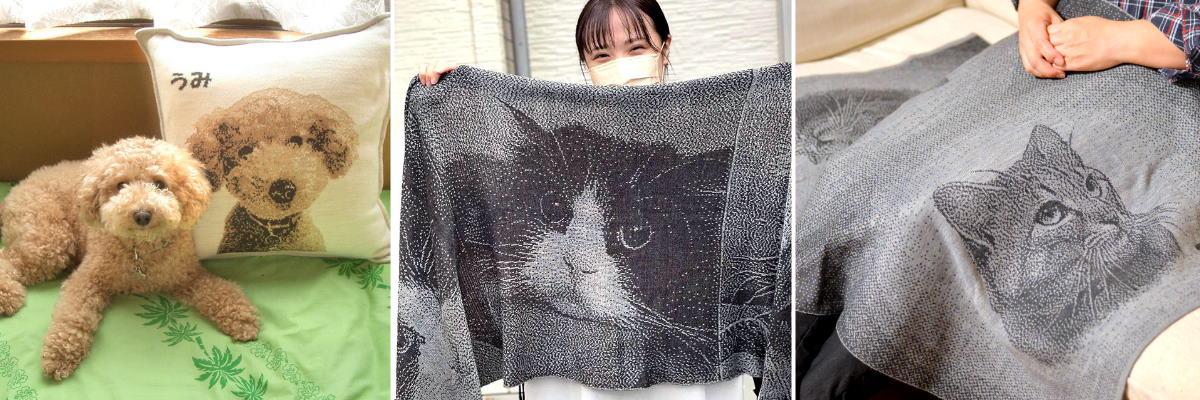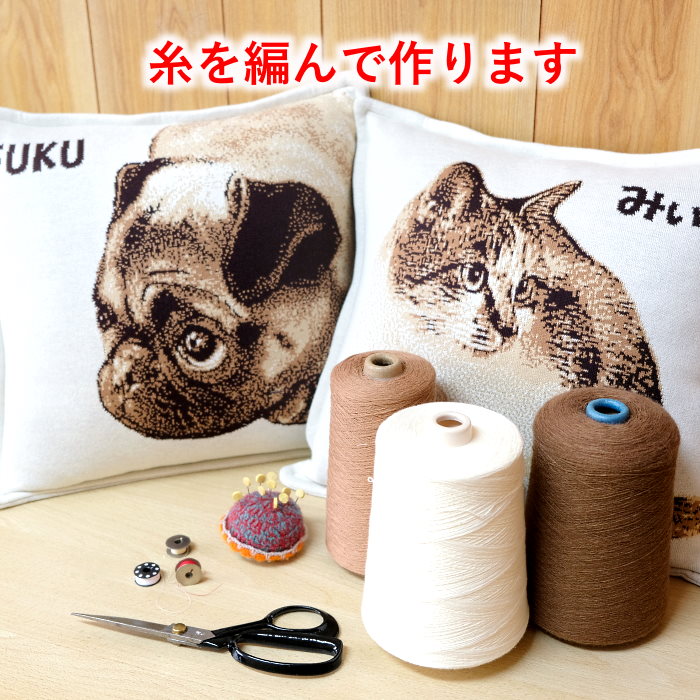When a beloved pet passes away, one of the most emotionally difficult tasks is sorting through their belongings.
Right after saying goodbye, deciding what to keep and what to part with can feel overwhelming. Many pet owners struggle with this step in the grieving process.
In this article, I’d like to share some insights on how others have handled this situation—and which items people often regret discarding too quickly.
As someone who creates custom memorial goods for pets, my job goes far beyond simply crafting keepsakes. I often receive heartfelt messages and consultations from our customers, and I believe it’s part of my mission to offer emotional support and guidance where I can.
Today, I’d like to talk about a common question we receive: How should we sort through my pet’s belongings after they’ve passed?
Different Perspectives Within the Family: Handling Pet Belongings
Even within the same family, opinions can vary greatly when it comes to what should be kept and what should be let go after a pet dies.
Let me share my own experience.
Our family dog, Muku, passed away in 2007.
Here is a photo of me and our dear Muku.
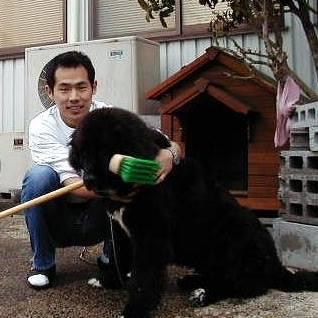
We were all devastated by his passing, but when it came time to sort through his things, there was a noticeable difference in how each family member approached it.
I wanted to keep as many items as possible.
But my father believed everything should be thrown away.
He felt that keeping physical reminders would only prolong the sadness and make moving forward more difficult.
In the end, despite the pain, we disposed of almost everything—his collar, leash, bandana. Only photos remained.
This experience taught me something important: even close family members may have vastly different emotional needs during grief.
Take Time Before Making Any Final Decisions
Once something is gone, it can’t be recovered.
That’s why it’s important to take your time. Talk with your family. Reflect on what each item means to you before deciding what to keep or discard.
If you feel unsure or emotionally unstable, don’t rush to make any decisions. It’s okay to set things aside and revisit them when you’re ready.
Personally, I deeply regret throwing away Muku’s bandana and collar.
I wish I had saved them and turned them into something meaningful—something that could have preserved his memory in a tangible way.
If you’re considering transforming your pet’s belongings into keepsakes, I encourage you to explore some creative memorial item ideas.
It may help you heal, and you won’t be left with the regret of having let go of something irreplaceable.
Should You Organize Your Pet’s Belongings or Leave Them As They Are?
Is it better to clear everything out, as my father believed?
Or is it more healing to keep something to remember your pet by?
There’s no single answer—only what feels right to you.
When You’re Unsure, It’s Okay to Hold On
Many of the messages we receive from customers express this kind of uncertainty:
“I’m not sure if I’m ready to organize my pet’s things yet.”
“I know I’ll eventually let go of them, but for now, I just want to keep them close.”
If you’re still undecided, that’s a sign you don’t have to make a decision yet.
Once something is gone, you can’t get it back. If there’s even a small part of you that wants to keep something, it’s okay to wait.
There may come a time when you naturally feel, “I think I’m ready now.”
When that moment arrives, you can let go in a way that brings peace, not regret.
The Benefits of Letting Go
Although I regretted parting with my dog’s belongings at first, I later came to see some positive effects.
Getting rid of everything may have helped me mentally shift forward.
And because there are no physical reminders left, I find myself treasuring the memories more deeply.
Even now, I still feel my dog’s presence with me, so I rarely feel lonely.
Had I kept many physical items, I might have cried every time I looked at them.
So in some ways, parting with them helped me heal.
It’s a Personal Journey—Take the Time You Need
Everyone grieves differently. There’s no “correct” way to deal with a pet’s belongings.
Your feelings may evolve over time. And sometimes, hearing other people’s stories or perspectives can give you the clarity you need.
Some of our customers say that talking with us helped them find peace.
By the time their custom memorial cushion arrived, they felt more emotionally settled and ready to move forward.
Others begin by holding onto everything—and gradually, as they’re ready, they start letting go, one item at a time.
Please take a look at our customers.
We ordered this cushion immediately after our family dog Luku, who we had spent 16 and a half years with, passed away. Our house, which was designed to care for an elderly dog, is gradually becoming more suitable for humans, so we wanted to increase the number of Lukus we have.
When my daughter saw the cushion, she cried, saying, “It’s Luku!” I cried too.
My daughter is holding the cushion as if she were holding Luku.
How to Dispose of a Deceased Pet’s Belongings
There are several respectful ways to handle your pet’s belongings after they’ve passed.
Here are some meaningful options to consider.
Cremating Items with Your Pet
In Japan, cremation is the most common way to say goodbye to a pet.
For many pet owners, it brings peace to send their pet to heaven with a few cherished items—perhaps a favorite toy, a piece of clothing, or even a heartfelt letter.
This symbolic gesture allows the pet to be surrounded by love, even in their final moments.
Please note, however, that some materials such as metal or plastic may not be suitable for cremation. Be sure to check with the crematorium staff beforehand.
Donating Pet Items to Others
If you have unused pet supplies—like extra pee pads, a crate that was rarely used, or unopened food—consider passing them on to someone who could use them.
Even if you don’t know anyone personally, animal shelters often welcome donations of clean, unused supplies like litter, food, or toys.
Reusing these items not only helps other animals in need, but can also feel like a small way to honor your pet’s memory.
By giving back, you’re turning your loss into an act of kindness—and that’s something your pet would surely be proud of.
Storing Your Pet’s Belongings in a Separate Room
If seeing your pet’s belongings around the house brings you too much pain—but throwing them away feels impossible—there’s a gentle alternative you might consider.
One option is to gather everything and store it in another room.
This way, the items won’t be visible in your daily life, but they’ll still be close by whenever you feel ready to revisit them.
Someone once shared this story with me:
“My husband gets upset when he sees our dog’s things.
It’s not anger, really—he ends up crying.
He tells me to put everything away because he doesn’t want to be reminded.
He was the one who loved our dog the most.”
This woman wanted to display her pet’s clothes and toys, but her family didn’t agree, so she keeps them tucked away instead.
Still, she might take them out to look at on her pet’s birthday or the anniversary of their passing—quietly remembering the love they shared.
After our beloved dog passed away, the whole family was feeling depressed, so we found this product and ordered a cushion.
Right after he passed away, it was so hard to leave anything behind, so we put away all the photos, collar, and other accessories out of sight, but perhaps the timing was perfect, as everyone was overjoyed to receive this cushion and said they were happy to be with him again.
We’ll take turns cuddling him and using it with care. Thank you very much.
Is It Easier to Heal After a Pet’s Death by Keeping or Letting Go of Their Belongings?
Which helps you recover faster from the shock of losing a beloved pet—keeping their belongings or letting them go?
Some people say that holding onto a pet’s items only prolongs the sadness.
Others feel that having keepsakes nearby eases the loneliness and helps them cope.
On the other hand, some find peace in clearing things out quickly, while others later regret having done so.
Everyone grieves differently. There’s no single right answer.
What matters most is choosing the path that feels right for you.
If you think you might regret discarding things too soon, consider setting them aside somewhere out of sight for now.
If you’re able to carry on with life while they’re stored away, you can always revisit the decision later.
Sometimes, after months or even years, looking back at those items can bring a comforting sense of, “I’m glad I kept these.”
Creating some distance from the items may give you the emotional space you need to reflect and process your feelings.
Either way, overcoming the sadness of parting with a pet is never easy.
It takes time—so be gentle with yourself and allow the healing to happen at your own pace.
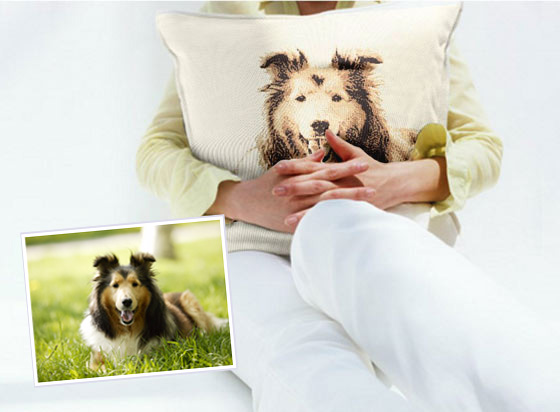
In Closing
If you want to keep some of your pet’s belongings, that’s perfectly okay.
You can also choose to part with larger items—like crates—or toys your pet rarely played with.
Some things hold deep memories and emotional meaning, so it’s important to take your time when deciding what to keep and what to let go.
The time it takes to heal from the loss of a pet varies greatly from person to person.
Some people manage to smile in front of others, only to cry when they return home.
Others begin to recover little by little by talking with someone they trust.
And some may remain in sadness for a very long time.
That’s why there’s no one-size-fits-all approach to sorting through a pet’s belongings.
During such times, having someone to share your sorrow with can make a world of difference.
Do you have a loved one—family, a friend, a partner—who can help support your heart?
If reading this has brought even a small bit of comfort to you, I’m truly grateful.
Customer example
Even toys that you have thrown away can be used to create designs.
Apparently, corgi loved her toy soccer ball.
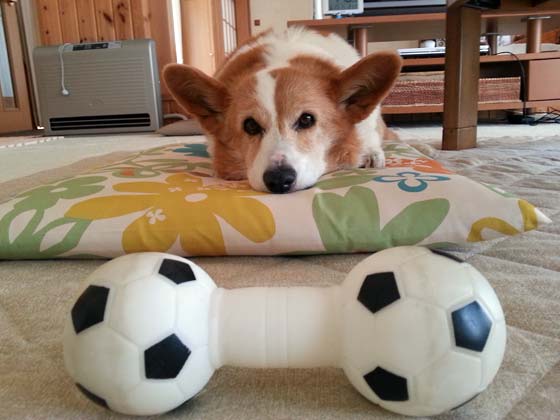
At the customer’s request, we also included toys in the cushion design.
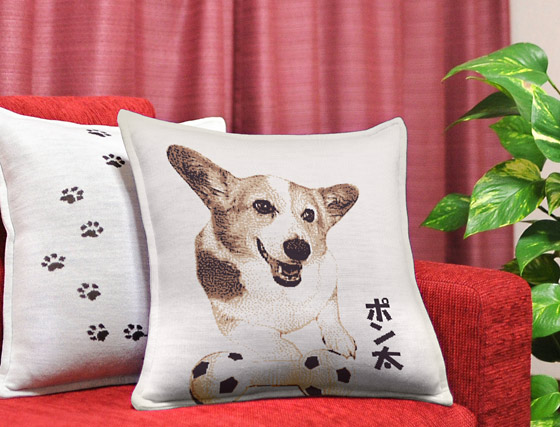
Click here for details on the cushion
After our beloved dog passed away and the whole family was feeling depressed, we found this product and ordered a cushion.
We didn’t specify expedited delivery, but they made and shipped it in just one week, so it was a very quick response.
It was so hard to leave anything behind so soon after he passed away that we put away all the photographs, collars and other accessories out of sight, but perhaps the timing was perfect as everyone was overjoyed to receive the cushions, saying how happy they were to be with him again.
We will take turns cuddling them and using them with care. Thank you very much.
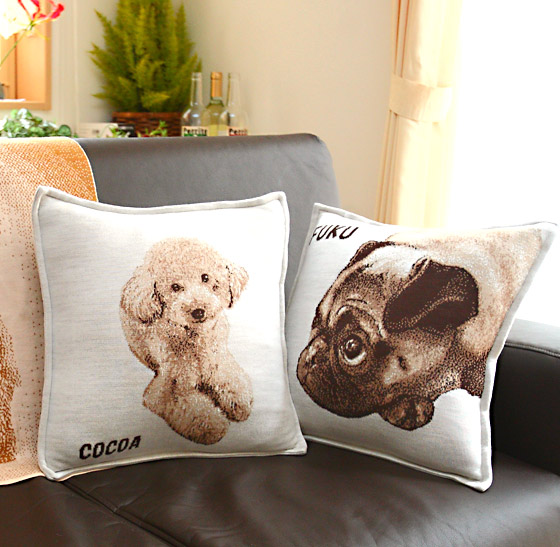
Knit Cushion
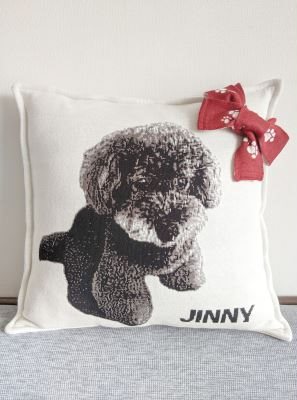
Knit Cushion
